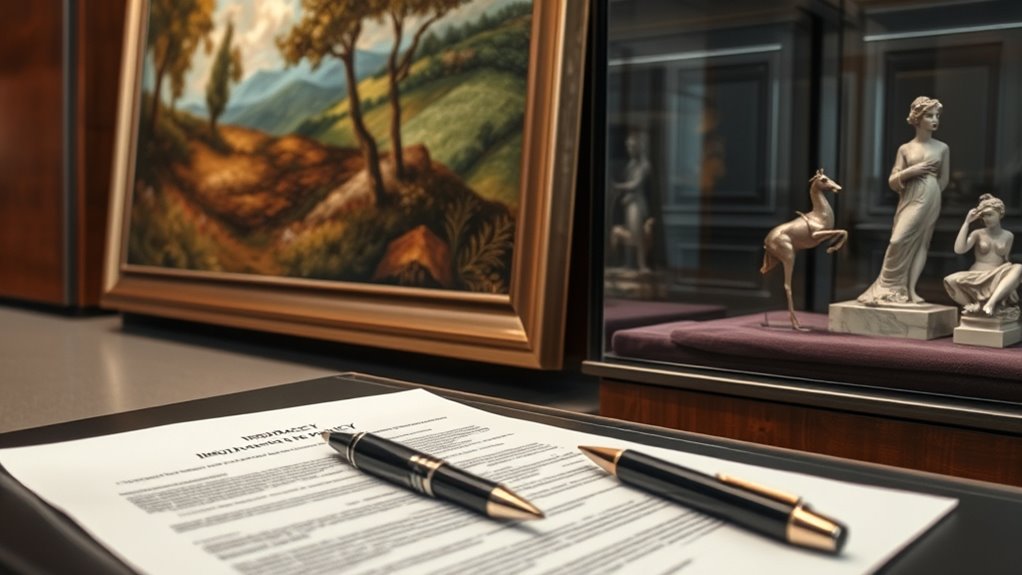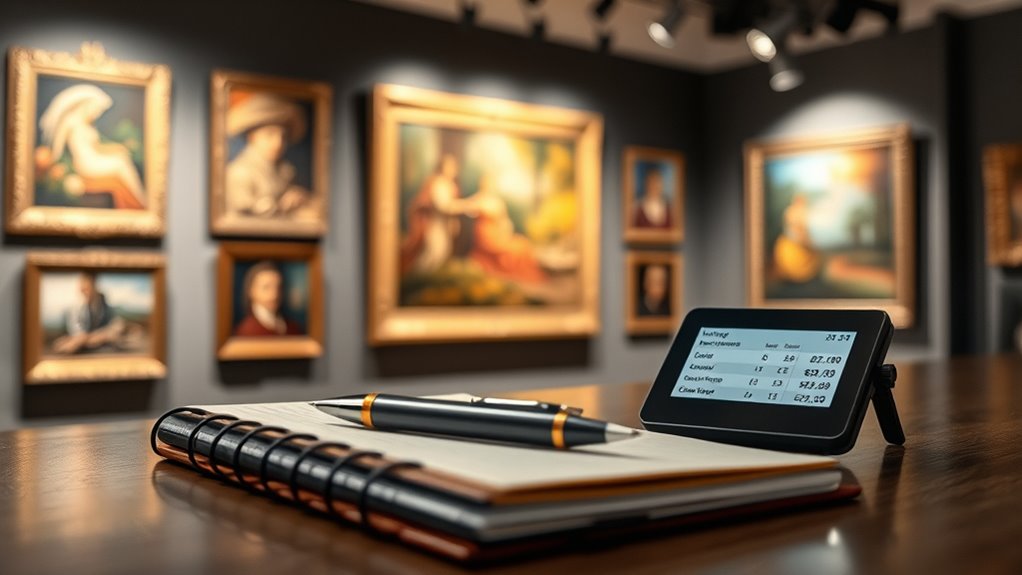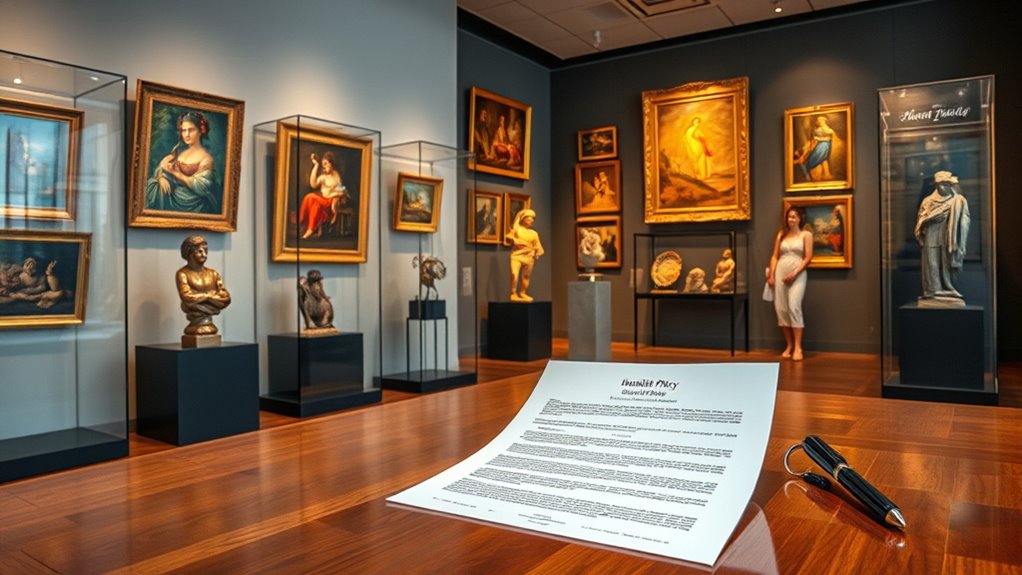To guarantee your art collection properly, start by evaluating its true value through professional appraisals, detailed documentation, and photos. Choose extensive policies like all-risk or open-peril coverage suited to your collection’s worth. Set appropriate coverage limits and deductibles based on market trends and your financial comfort. Regularly update records and policies to reflect changes, and ensure your artwork is stored safely. Discover more ways to protect your collection effectively as you explore further.
Key Takeaways
- Obtain professional appraisals to determine accurate collection values for appropriate coverage limits.
- Choose comprehensive insurance policies, such as all-risk or open-peril, to maximize protection.
- Keep detailed records with photographs, provenance, and condition reports for easy claims processing.
- Store artwork securely in climate-controlled environments and use professional transportation when moving pieces.
- Regularly review and update coverage limits and deductibles based on market fluctuations and collection changes.
Assess the Value of Your Art Collection

How do you determine the true worth of your art collection? Start by exploring appraisal techniques, which include comparing similar pieces, examining provenance, and consulting professional appraisers. These methods help establish a fair market value based on current data. It’s also essential to stay informed about art market trends, as fluctuations in demand and economic shifts can profoundly impact your collection’s worth. Regularly reviewing these trends ensures your valuation remains accurate. Remember, an accurate assessment isn’t just about current prices; it considers the artwork’s condition, rarity, and historical significance. To enhance your valuation process, understanding market fluctuations and their impact on art prices can provide valuable insights. By combining appraisal techniques with an understanding of market trends, you can confidently determine the true value of your collection, laying a solid foundation for proper insurance coverage.
Understand Different Types of Art Insurance Policies

Understanding the different types of art insurance policies is essential to guarantee your collection is adequately protected. These policies vary based on coverage scope, valuation method, and claims process. For example, professional recommendations often emphasize the importance of selecting a policy aligned with the specific needs of your collection. 1. All-Risk Policies: Cover most risks, including theft, fire, and accidental damage, often requiring an art appraisal to establish value. 2. Named-Peril Policies: Cover specific risks you select, offering tailored protection but limiting coverage for unlisted events. 3. Valued Policies: Set a fixed price based on an art appraisal, simplifying insurance claims but risking under- or over-insurance if the value changes. 4. Open-Peril Policies: Provide broad coverage, including unforeseen damages, ideal for high-value collections. Choosing the right policy ensures smooth insurance claims and proper protection for your art collection.
Document Your Art Pieces Thoroughly

Once you’ve selected the appropriate insurance policy, the next step is to guarantee your art collection is thoroughly documented. Start by conducting a professional art appraisal for each piece, providing accurate descriptions, provenance, and estimated values. Keep detailed records, including photographs from multiple angles, to capture condition and unique features. Consider storage solutions that protect your art from damage and deterioration; proper storage ensures your documentation remains accurate over time. Organize this information in a secure digital or physical file, making it easy to access and update as needed. Clear documentation not only supports your insurance claims but also helps verify ownership and value, providing peace of mind knowing your collection is well-protected through meticulous record-keeping. Additionally, understanding dog breeds and their unique traits can help you better identify and authenticate your collection, especially if you own or collect canine-themed art or memorabilia.
Choose a Reputable Insurer Specializing in Art

You want an insurer with strong expertise in art insurance, so make certain they understand your collection’s unique needs. Verify their licensing and credentials to ensure they’re legitimate and trustworthy. Choosing a specialized insurer helps protect your valuable pieces effectively. Additionally, understanding how sound vibrations can influence health and well-being may inform how you care for and preserve your collection.
Specialized Expertise Matters
Choosing a reputable insurer with specialized expertise in art guarantees your collection receives the right coverage and professional assessment it deserves. Such insurers offer expert consultation, assuring you understand your policy’s nuances. They utilize advanced art valuation techniques, accurately appraising your pieces’ worth. Imagine:
- An art appraiser examining your paintings with a loupe, noting subtle details.
- A detailed cataloging process, capturing each artwork’s unique features.
- Precise documentation that reflects current market value.
- Professional advice tailored specifically to your collection’s needs.
- Understanding art spoilage signs helps ensure your collection is kept in optimal conditions, maintaining its value over time.
This specialized approach guarantees your art is protected against risks that general insurers might overlook. Partnering with experts in the field gives you confidence that your collection is valued correctly and covered thoroughly, minimizing surprises when you need to file a claim.
Verify Licensing and Credentials
Partnering with an insurer that specializes in art requires more than just reputation—it demands verifying their licensing and credentials. You should start by confirming their licensing verification through official regulatory bodies to ensure they’re authorized to operate in your area. Additionally, ask about their experience with gallery authentication, which demonstrates their familiarity with art-specific risks. A reputable art insurer will have proper credentials and a proven track record in insuring high-value collections. Don’t hesitate to request proof of licensing and credentials, and verify these details independently if possible. This step protects you from potential scams and ensures you’re working with a qualified professional who understands the nuances of insuring art, giving you peace of mind that your collection is in capable hands. Verification of licensing is an essential part of selecting an insurer, ensuring compliance with industry standards and protecting your investment.
Determine Coverage Limits and Deductibles

To set your coverage limits and deductibles, you need to first assess the value of your art collection accurately. Then, choose deductibles that balance affordability with adequate protection, and determine coverage limits that reflect the total worth of your pieces. Making these decisions carefully guarantees you’re well-protected without overpaying for coverage. Additionally, understanding projector technology can help you appreciate the importance of proper insurance for high-value items like art.
Assess Art Value
Have you ever wondered how to accurately determine the value of your art collection for insurance purposes? To do this, you need a clear understanding of its worth through proper assessment. Start by considering:
- Art provenance, which confirms authenticity and history, boosting value.
- Artistic valuation, involving expert appraisals to determine current market price.
- Recent sale prices of similar works to gauge market trends.
- Condition reports that affect an artwork’s worth, noting any damage or restoration.
- Recognizing the impact of vibrational energy on perceived value, as attitudes and beliefs can influence market interest and personal appreciation.
Choose Appropriate Deductibles
Choosing the right deductible is essential to ensuring your art collection is adequately protected without overpaying for coverage. When selecting deductible options, consider how much you’re willing to pay out of pocket in the event of a claim. Different appraisal methods can influence your deductible choices, as accurate appraisals help determine fair coverage and appropriate deductibles. A higher deductible typically lowers your premium but increases your financial responsibility if a loss occurs. Conversely, a lower deductible means higher premiums but less out-of-pocket expense when filing a claim. Evaluate your financial situation and risk tolerance to find a balance that suits you. Additionally, understanding angel number soulmates can offer insights into recognizing signs of favorable opportunities and timing for your collection’s protection and growth. Carefully review your policy, ensuring the deductible aligns with your collection’s value and your ability to handle potential costs.
Set Coverage Limits
Setting appropriate coverage limits is essential to ensuring your art collection is fully protected without overspending on insurance. To do this, consider current art market trends and reliable art valuation methods. First, analyze recent sales of similar pieces to gauge market value. Second, consult appraisals from certified experts to establish accurate valuations. Third, review fluctuations in art market trends that could impact your collection’s worth. Fourth, determine a coverage limit that reflects these valuations, avoiding underinsurance or excessive premiums. Remember, setting an appropriate limit balances protection with affordability. Additionally, understanding insurance policy terms can help you better navigate coverage options and exclusions. Regularly reassess your coverage as market conditions change to keep your art fully protected and accurately valued over time.
Keep Your Documentation and Insurance Policies Up to Date

Keeping your documentation and insurance policies up to date is essential to guarantee your art collection remains properly protected. Regularly review and update your records, especially after acquisitions or changes in storage solutions and security measures. Accurate documentation ensures swift claims processing and verifies your coverage aligns with your collection’s current value. Use the table below to remind yourself of key emotional touchpoints:
| Protecting Memories | Ensuring Peace of Mind | Securing the Future |
|---|---|---|
| Cherished moments | Confidence in coverage | Legacy preservation |
| Confidence in protection | Peace during emergencies | Art’s lasting impact |
| Trust in your security | Assurance of safety | Protecting tomorrow |
Staying proactive guarantees your collection’s safety and your peace of mind. Incorporating sound design techniques like layering sound effects or utilizing advanced tools can enhance the atmosphere and emotional resonance of your collection’s presentation or documentation process.
Safeguard Your Art to Minimize Risks

Updating your documentation and insurance policies is a vital step in safeguarding your art collection, but it’s equally important to implement practical measures that reduce the risk of damage or loss. Proper art storage keeps pieces in a climate-controlled environment, away from sunlight, moisture, and pests. When it’s time to move your art, prioritize secure art transportation with professional handlers and specialized packaging. Additionally, understanding insurance laws for art can help you ensure comprehensive coverage that reflects your collection’s value. Consider these steps: 1. Store artwork in a dedicated, climate-controlled space. 2. Use padded, custom crates for transport. 3. Hire experienced art shippers for delicate pieces. 4. Avoid frequent or unnecessary handling to minimize risk.
Frequently Asked Questions
How Often Should I Review or Update My Art Insurance Policy?
You should review and update your art insurance policy regularly to guarantee your coverage stays accurate. Typically, it’s best to do this after major art appraisals or when acquiring new pieces. Also, remember to check your policy renewal date; renewing on time helps prevent gaps in coverage. By staying proactive and updating your policy with current appraisals, you protect your collection and avoid surprises if you need to file a claim.
What Are Common Exclusions in Art Insurance Policies?
You should be aware that art insurance policies often have exclusions, so it’s essential to review your policy carefully. Common exclusions include damage from neglect, war, or natural disasters like floods or earthquakes. An art appraisal can help you understand your collection’s value and guarantee coverage. Always ask about policy exclusions when purchasing or updating your insurance, so you’re fully protected against unforeseen events.
How Does Art Valuation Affect Insurance Premiums?
Art valuation directly impacts your insurance premiums because higher-valued pieces require more coverage and consequently cost more to insure. When you get an accurate art valuation, it helps guarantee you’re not overpaying or underinsuring your collection. If your art is appraised at a higher value, expect premiums to increase accordingly. Proper valuation ensures your premiums reflect the true worth of your collection, giving you peace of mind and adequate coverage.
Can I Insure Artwork in Storage or Transit?
Secure your stash by insuring artwork in storage and transit, ensuring safety from sudden shocks. You can absolutely insure your artwork during storage, provided you have solid storage security, and while in transit, with all-encompassing transit coverage. Always verify your policy’s specifics, so your art’s asset remains protected against accidental damage, theft, or loss during these vulnerable moments. Don’t leave your treasures unguarded—insure them everywhere they go.
What Steps Should I Take After a Theft or Damage?
After theft or damage, you should immediately contact the police and your insurer. Make sure you follow proper documentation practices by taking detailed photos and notes of the damage or theft scene. Review your security measures to identify any vulnerabilities. Keep all receipts, appraisals, and related documents organized. Reporting quickly helps with claims processing, and maintaining thorough records ensures your case is handled efficiently and accurately.
Conclusion
Protecting your art collection is like tending a delicate garden—you need to nurture, document, and stay vigilant. By understanding policies and keeping everything up to date, you ensure your treasures remain safe amidst life’s uncertainties. Don’t let gaps in coverage be cracks in your fortress; instead, insulate your collection with proper insurance. With careful planning, your art will continue to shine brightly, safeguarded against life’s unpredictable storms.









